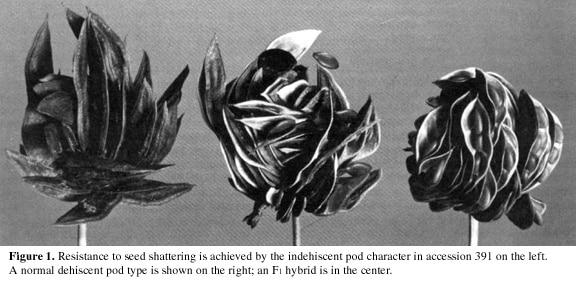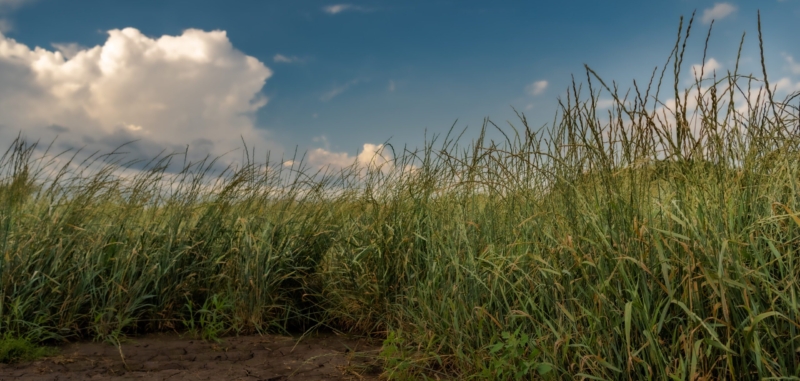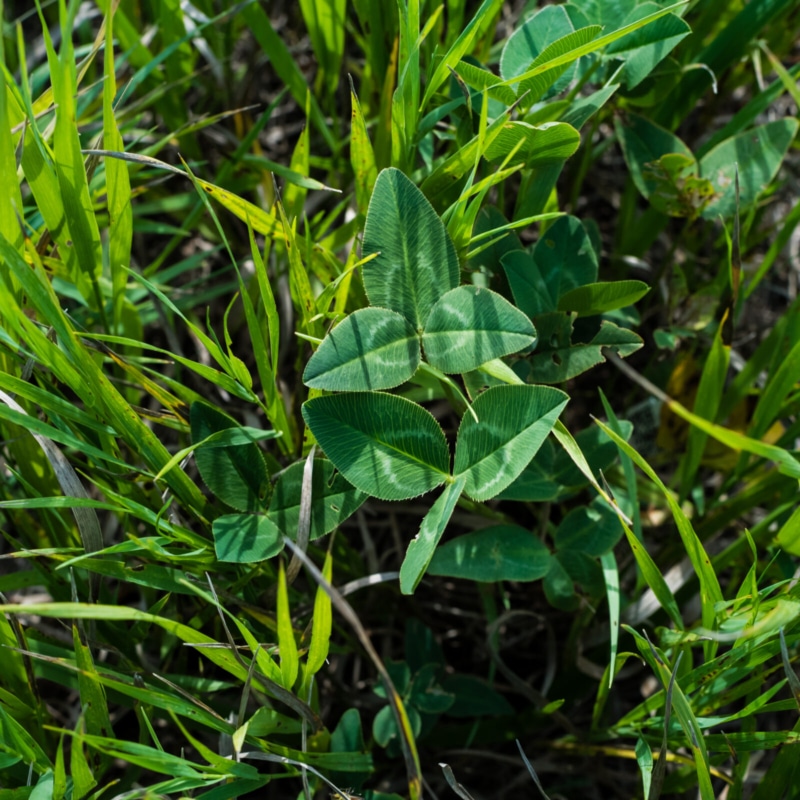Introduction
Illinois bundleflower (Desmanthus illinoensis (Michx.) MacM.) is a warm season perennial legume of the North American grasslands. Native stands occur in a variety of habitats, including rocky open ground, wooded slopes, prairies, stream banks, roadsides, and along railroad rights-of-way. In this paper, we review the prospects for domesticating Illinois bundleflower as a perennial seed crop and consider the species’ nutritional value, nitrogen fixation capacity, and potential for genetic improvement. In our efforts to achieve a sustainable agriculture, we are using the native grasslands of the Great Plains as a model for an agriculture based on domestication of herbaceous perennial species as seed crops. These crops are selected for cultivation in polycultures as contrasted with the extensive annual grain crop monocultures typical of North American agriculture. These perennial crops would protect soil from erosion and reduce traction power requirements, while the ecological functioning of polycultures would help maintain soil fertility and control pathogens, weeds, and phytophagous insects.
P.A. Kulakow, L.L. Benson, and J.G. Vail (1990). Prospects for domesticating Illinois bundleflower. In Advances in New Crops. Proceedings from the First National Symposium New Crops: Research, Development, Economics, J. Janick and J.E. Simon, eds. Indianapolis, Indiana, October 23-26, 1988, pp. 168-171. Published in 1990 by Timber Press. Used by permission.
*We acknowledge the contributions of Mary Bruns, Veronica Mecko-Ray and photography of John Thelander.
Benefits
Illinois bundleflower is rated by some authorities as our most important native legume and is included in range revegetation programs since the species is readily eaten by livestock (Great Plains Flora Association 1986). The lenticular seeds contain 38% protein on a dry weight basis, which compares favorably with soybean (Glycine max (L.) Merr.) (Table 1). Chick feeding trials and analyses of foliage and seed by the USDA Poisonous Plants Research Laboratory found no toxic levels of oxalates, cyanides, nitrates or alkaloids (M. Cobum Williams, pers. comm.).
Our long term objective is to use Illinois bundleflower to meet human nutritional needs. Illinois bundleflower seed proteins are rich in sulfur-containing amino acids and limiting in valine, isoleucine, tryptophan, lysine, and threonine compared to the FAO standard reference protein (Table 2). Additional analysis by the University of Nebraska Food Protein Research Group found protein in uncooked seed to be 69% digestible with digestibility rising to 80% and 83% after boiling seed for 30 and 60 minutes, respectively (Lowell Satterlee, pers. comm.). Computed Protein Efficiency Ratios indicate that while cooked Illinois bundleflower seed may be lower in protein quality than soybeans or casein, it appears to be greater or equal to whole corn, wheat, and cooked oats (Table 3). This preliminary information indicates that further analysis of the nutritional quality of Illinois bundleflower is warranted. As the seed leaves an unpleasant aftertaste studies are needed to determine the cause of seed unpalatability. While the seed contains no detectable levels of tannins (Larry Butler, pers. comm.), other chemical compounds may affect flavor.
As part of a perennial mixed cropping system incorporating warm season and cool season grasses, Illinois bundleflower could provide a harvest of nutritious seed and enhance soil fertility through biological nitrogen fixation. The percentage of nitrogen derived from symbiosis in perennial native legume species is likely to be greater than that of annual grain legumes, as the nodules are perennial and fixation may begin earlier than in annuals (Salisbury and Ross 1985). Appreciable amounts of nitrogen transfer from perennial forage legumes to grasses occurs in mixed swards (Brophy et al. 1987). This nitrogen transfer from legume components could be a significant factor in maintaining soil fertility of perennial polycultures. We screened 37 accessions of Illinois bundleflower for nitrogen fixation as measured by acetylene reduction. Seventy day old seedlings had an average activity per plant of 141 ± 65 nmoles/min. These data are comparable to acetylene reduction rates found in ‘Corsoy’ soybean and alfalfa (Medicago sativa L.) (Undemann et al. 1982, Duhigg et al. 1978). Significant variation among accessions in mean acetylene reduction rate per plant, ranging from 40 to 302 nmoles/min, suggests genetic variation in this trait which could be enhanced by a selection program.
Domestication
Natural populations of Illinois bundleflower are distributed from North Dakota and Minnesota in the north to New Mexico and Colorado in the west and from Texas to Florida in the south (Great Plains Flora Association 1986). We have assembled Illinois bundleflower germplasm collections from ten states and have begun evaluating morphological and phenological variation for agronomic potential. In 1987, 14 accessions were evaluated in a field nursery for 30 qualitative and quantitative descriptors to develop methods for describing agronomic characteristics of Illinois bundleflower and to identify characteristics that would be important for breeding cultivars (Mecko-Ray 1987). Means and ranges for eight phenological and yield related descriptors are summarized in Table 4. Time of peak flowering was positively correlated with 100 seed weight (r=0.56, n=14) but negatively correlated with seed weight per plant (r=-0.57). Plant growth characteristics that seemed most likely to affect agronomic performance included duration of flowering or synchrony, presence of determinate vs. indeterminate branching patterns and a tendency toward a prostrate vs. erect growth habit. In 1988, we began a three-year field evaluation of 82 accessions transplanted in a randomized complete block design with two replications. During the establishment year, data was collected on plant height, vegetative vigor and seed yield per plot. Analysis of variance showed significant differences among accessions for all characteristics. Mean seed yield per accession was 1200 kg/ha with a range of 615 to 1700 kg/ha. Seed yield was correlated with both vegetative vigor (r=0.45, n=80) and plant height (r=0.50). The germplasm represented ten states with most of the accessions from Kansas (n=46) and Oklahoma (n=18). Sixteen of the 30 lowest yielding accessions were from Oklahoma, with only one accession from Oklahoma yielding above the mean. Kansas accessions averaged 1290 kg/ha while Oklahoma accessions averaged only 950 kg/ha. Accessions from Oklahoma also showed reduced vegetative vigor and plant height. These observations provide evidence of latitudinal geographic variation for adaptation to our central Kansas environment.
The most important variation observed in 1988 was resistance to seed shattering in accession 391 from Knoxville, Tennessee. Illinois bundleflower seed pods normally dehisce at maturity which results in high seed shattering if harvest is delayed after maturity. Accession 391 has indehiscent pods and is thus more shatter resistant. Three naturally occurring hybrids between 391 and normal dehiscent pod types have been identified and are being used to study the inheritance of this form of shatter resistance (Figure 1).

Future Outlook
Successful development of Illinois bundleflower as a perennial grain legume will require simultaneous progress in identifying uses for Illinois bundleflower seed appropriate for its nutritional value and selecting agronomically acceptable varieties. Perennial seed crops will most likely be used on land prone to soil erosion where annual plowing is undesirable. Use of Illinois bundleflower’s nitrogen fixation potential could reduce nitrogen fertilizer needs in perennial agroecosystems. Our initial breeding priorities are focused on selection for harvestabiity, including resistance to seed shattering and selection for stable high seed yields over multiple years. Preliminary data on nutritional value, nitrogen fixation, seed yield, and genetic variability in germplasm accessions suggest Illinois bundleflower has promise as a perennial grain legume.
References
Brophy, L. S., G. H. Heichel, M. P. Russelle. 1987. Nitrogen transfer from forage legumes to grass in a systematic planting design. Crop Sci. 27:753-758.
Duhigg, P., B. Melton, and A. Baltensperger. 1978. Selection for acetylene reduction rates in ‘Mesilla’ alfalfa. Crop Sci. 18:813-816.
Great Plains Flora Association. 1986. Flora of the great plains. Univ. Press of Kansas, Lawrence.
Lindemann, W. C., G. W. Randall, and G. E. Ham. 1982. Tillage effects on soybean nodulation, N2(C2H4) fixation, and seed yield. Agron. J. 74:1067-1070.
Mecko-Ray, V. 1987. Evaluation of Desmanthus illinoensis germplasm. The Land Institute Res. Rep. 4:24-28.
Piper, J., J. Henson, M. Bruns, and M. Bender. 1988. Seed yield and quality comparison of herbaceous perennials and annual crops, p. 715-719 In: P. Allen and D. Van Dusen (ed.). Global perspectives on agroecology and sustainable agricultural systems. Univ. of California, Santa Cruz.
Salisbury, F. B. and C. W. Ross. 1985. Assimilation of nitrogen and sulfur, p. 251-267. In: Plant physiology. (3rd ed.) Wadsworth Publishing Co., Belmont.














